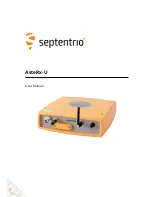
LA000605D © 2007 Navman New Zealand. All rights reserved. Proprietary information and specifications subject to change without notice.
6.0 Glossary and acronyms
Axial ratio:
For an electromagnetic wave having elliptical polarisation, the ratio of the
magnitudes of the major axis and the minor axis of the ellipse described by the electric field
vector.
EMI:
Electromagnetic Interference
ENIG:
Electroless Nickel Immersion Gold
FR4 substrate:
Flame Retardant type 4
The usual base material from which plated-through-hole and multi-layer printed circuit boards
are constructed. The type ‘4’ indicates woven glass reinforced epoxy resin.
GPS:
Global Positioning System
A space-based radio positioning system that provides accurate position, velocity, and time data.
LGA:
Land Grid Array
A physical interface for microprocessors. There are no pins on the chip; in place of the pins are
pads of bare gold-plated copper that touch pins on the motherboard.
LNA
: Low Noise Amplifier
A special type of amplifier used to amplify weak signals captured by an antenna.
MCX:
A type of miniature coaxial RF connector
NMEA:
National Marine Electronics Association
PCB:
Printed Circuit Board
RF:
Radio Frequency
SDK:
Software Development Kit
SMA:
SubMiniature version A connectors are coaxial RF connectors developed in the 1960’s
as a minimal connector interface for coaxial cable with a screw type coupling mechanism. The
connector has a 50 Ω impedance.
SRAM:
Static Random Access Memory
SMT:
Surface mount technology (SMT) is a method for constructing electronic circuits in which
the components are mounted directly onto the surface of printed circuit boards
TTFF:
Time-To-First-Fix
The actual time required by a GPS receiver to achieve a position solution. This specification
will vary with the operating state of the receiver, the length of time since the last position fix, the
location of the last position fix, and the specific receiver design.


































